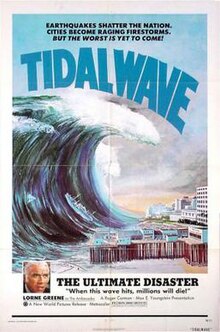Submersion of Japan
| Tidal Wave | |
|---|---|
 | |
| Directed by | Shiro Moritani |
| Screenplay by | Shinobu Hashimoto[1] |
| Produced by | |
| Starring | |
| Cinematography | |
| Edited by | Michiko Ikeda[1] |
| Music by | Masaru Sato[1] |
| Distributed by | Toho |
Release date |
|
Running time | 143 minutes[2] |
| Country | Japan |
| Budget | $3 million[2] |
| Box office | $7 million (Japan)[3] |
Tidal Wave (日本沈没, Nihon Chinbotsu, lit. Submersion of Japan) is a 1973 film directed by Shiro Moritani.[1] It is based on a novel Japan Sinks by Sakyo Komatsu.[1] The film stars Keiju Kobayashi, Hiroshi Fujioka and Ayumi Ishida.
Synopsis
Volcanic eruptions and earthquakes shake Japan. Firestorms burn beautiful Japanese cities to the ground. A weather survey group discovers that the Japanese Archipelago is moving towards the Japanese Trench, which if left to continue on its collision course, would bring the whole of Japan under the sea.
Cast
- Keiju Kobayashi - Dr. Tadokoro
- Hiroshi Fujioka - Onodera Toshio
- Ayumi Ishida - Abe Reiko
- Rhonda Leigh Hopkins - Fran
- Lorne Greene - Ambassador Warren Richards (U.S. release only)
- Tetsuro Tamba - Prime Minister Yamamoto
- Shogo Shimada - Watari
- John Fujioka - Narita
- Andrew Hughes - Australian Prime Minister
- Nobuo Nakamura - Japanese Ambassador
- Haruo Nakajima - Prime Minister's Chauffeur
- Hideaki Nitani - Dr. Nakata
- Isao Natsuyagi - Yuki
- Yusuke Takita - Assistant Professor Yukinaga
Release
Tidal Wave was released in Japan on 29 December 1973 where it was distributed by Toho.[2] The film was the highest grossing film in 1973 and 1974 in Japan.[2] The film grossed more than twice of the second-highest grossing film of the year, Human Revolution.[2]
American version
| Tidal Wave | |
|---|---|
 American release poster | |
| Directed by | Andrew Meyer |
| Produced by | Max E. Youngstein |
| Starring | |
| Cinematography | Eric Saarinen |
| Distributed by | New World Pictures |
Release date | May 1975 |
Running time | 90 minutes |
| Box office | $3.5 million (U.S.)[3] |
The American version of the film was released as Tidal Wave, released by New World Pictures with an English-language dub.[2] The film included new scenes and new cast members including Lorne Greene, Rhonda Leigh Hopkins, John Fukioka, Marvin Miller, Susan Sennett, Ralph James, Phil Roth, Cliff Pellow, and Joe Dante.[2] It was released in May 1975.[2] New World also released an uncut subtitled format as Submersion of Japan.[2]
Roger Corman bought the U.S. rights to the film for his New World Pictures. He cut out a great deal of footage and added new sequences directed by Andrew Meyer starring Lorne Greene as an ambassador at the United Nations. The film was a big success at the U.S. box office.[3]
Footnotes
Sources
- Galbraith, Stuart, IV (2008). The Toho Studios Story: A History and Complete Filmography. Scarecrow Press. ISBN 1461673747.
{{cite book}}: Invalid|ref=harv(help)CS1 maint: multiple names: authors list (link)
